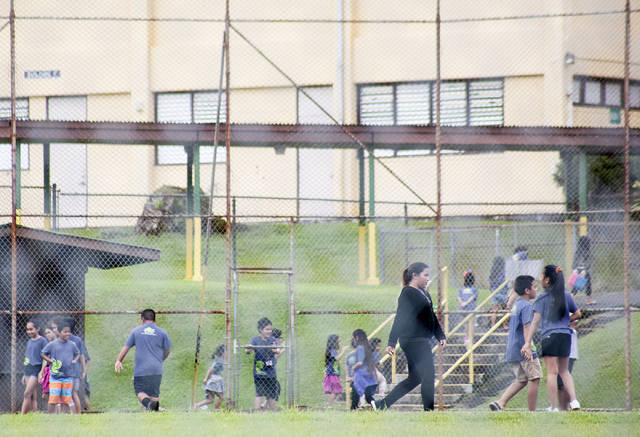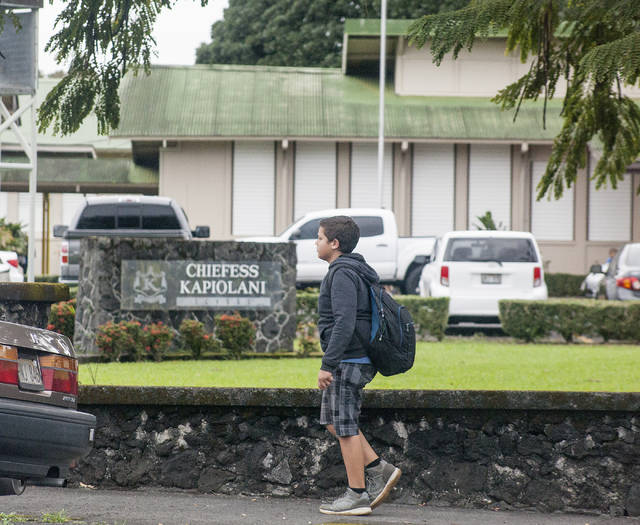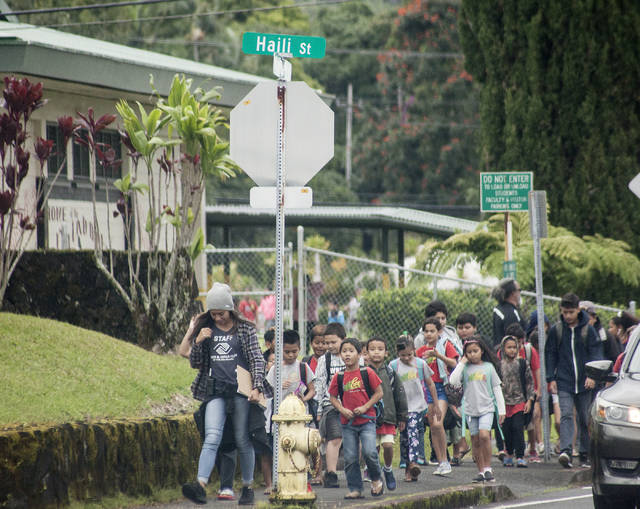The state Department of Education and Department of Health are implementing environmental hazard management plans at 18 East Hawaii schools after a study found elevated levels of contaminants such as lead, arsenic and chlordane in the soil at those facilities.
According to a joint news release set to be issued this morning, the review was initiated in 2017 to evaluate the presence of arsenic in soil due to the historic use of arsenic-based herbicides when the land was used for sugar cane cultivation before the schools were built.
Assessments of lead and pesticides such as chlordane were included in the study because historically they were known to be used in lead paint and termite treatments.
The 18 schools are:
• DeSilva Elementary (arsenic and lead),
• Haaheo Elementary (lead),
• Hilo High (lead),
• Hilo Intermediate (lead),
• Hilo Union Elementary (chlordane and lead),
• Kalanianaole Elementary and Intermediate (lead),
• Kapiolani Elementary (arsenic, chlordane and lead),
• Ka‘u High and Pahala Elementary (chlordane and lead),
• Kaumana Elementary (lead),
• Keaau Middle (arsenic and lead),
• Keaukaha Elementary (lead),
• Laupahoehoe High and Elementary (lead),
• Mountain View Elementary (lead),
• Naalehu Elementary and Intermediate (lead),
• Pahoa Elementary (chlordane and lead),
• Pahoa High and Intermediate (arsenic, chlordane and lead),
• Waiakea Intermediate (arsenic),
• and Waiakeawaena Elementary (chlordane and lead).
Letters to parents are expected to go home today.
Diana Felton, state toxicologist with the DOH Hazard Evaluation and Emergency Response Office, said the study looked at soil samples at 23 schools.
It was found that 17 had elevated levels of lead in the surrounding soils, six had elevated levels of organochlorine pesticides and five had elevated levels of arsenic, while five schools had no findings, she said.
According to Felton, contaminated soil was found mostly around the edges of buildings, or the building perimeters.
“Very rarely did they find any in open space areas or garden plots.”
Felton said that makes sense because of how the chemicals were used historically, including lead paint on the sides of buildings, arsenic used as an herbicide and chlordane used around foundations to fight termites.
People are primarily exposed to these chemicals in the soil through unintentional ingestion, she said, meaning the chemicals are in the dirt, which can then get on hands and then onto food.
The biggest concern is for smaller children who are more likely to put their hands in their mouths and who are more sensitive to the effects of the chemicals, Felton said.
Based on current amounts in the soils and the method of exposure, however, Felton said the DOH does not see this as a “potential significant health risk.”
Fenix Grange, assessment and remediation supervisor for the HEER office, said the DOH does not have any documented cases in Hawaii of arsenic-contaminated soil causing adverse health effects in humans.
Felton said that if present, school garden plots were tested, three of which had moderate levels of lead and one had high levels of arsenic.
While garden activities at those schools were suspended or relocated, Felton said generally the amount of chemicals absorbed by the edible parts of vegetables and fruits is not a concern, and food from those gardens can still be consumed safely.
But residual contaminated soil on the vegetables could be a problem.
According to Felton, produce should be washed carefully, and recommendations about careful hand-washing after coming into contact with the soil continue to apply.
According to the DOE, previous studies by the DOH and other agencies found arsenic contamination in former sugarcane lands.
HEER found arsenic contamination in the former garden area of Keaau Middle School, which provided the impetus to expand the investigation to other East Hawaii schools.
“It’s more of we acknowledge the fact that a lot of our schools are on previous agriculture kind of land, and some of our schools to this day neighbor (agricultural land),” said Dann Carlson, assistant superintendent with the DOE Office of School Facilities and Support Services. “We want to make sure we’re doing the right thing and we’re proactive.”
That was a sentiment shared by Grange, who said the DOE “chose to do it in the interest of protecting the students and gathering more information. The DOE proactively decided to look for all of these things at schools on the Big Island.”
John Chung, public works administrator for the DOE’s Facilities Development Branch, said the initial target of the study was to look for arsenic contamination, but “what was surprising was those levels weren’t nearly as high or as of concern as originally thought. But what we did discover was there was a lot of lead contamination in the ground,” which changed the focus of the effort.
Carlson said the DOE followed the DOH’s lead, and if “they felt there was a need for us to abandon the use of our facility, they would dictate that.”
“The safety and well-being of our students and staff is a high priority, and work is already underway to minimize potential health risks,” said Superintendent Christina Kishimoto in the news release. “With many of our communities sited on former sugar or other agricultural lands, the potential for soil issues can be fairly high, and we continue to work diligently with the Health Department to implement mitigation measures at each of our impacted schools.”
The cost of the study was $587,235.
Chad Keone Farias, complex area superintendent for the Ka‘u-Keaau-Pahoa and the Hilo-Waiakea complex areas, said the school grounds are “the same fields and the same paths and walkways we walked on (as children), that we played on. Now that we understand it better, we can take certain precautions that have been highlighted in our mitigation report.”
The concern is making sure principals and the public don’t panic, he said.
Farias said he wasn’t surprised by the study’s findings.
The contaminations were “things we knew about growing up as kids because of where we live. My parents made us aware of where we plant our food, where we play.”
“I would say from my standpoint, this report was actually reassuring,” he said. “It confirmed the ground that we are walking on and playing on is safe to walk and play on, (but it) also confirms this is not the soil we want to be ingested.”
Farias said children need to run and play, but schools also want to follow guidelines from the DOH.
“In the end, we hope to communicate well with our community, and this will lead to safer schools or all of our kids and employees,” he said.
According to Carlson, the DOE’s next focus will be studies in areas on Oahu that previously were or are currently next to agricultural areas.
Those results will be combined with the results from the Hawaii Island study, “and we’ll come up with a plan at that point.”
The safety precautions they’re issuing now, however, are being offered throughout the DOE.
State Health Director Bruce Anderson said in the news release that such contamination is not unique to schools and could persist around any older home or building.
“We need to be vigilant and understand how to protect ourselves and our children from these chemicals,” he said. “We are sharing this information out of an abundance of caution, and want to reassure the public that exposure to lead, arsenic and organochlorine pesticides is preventable.”
Children should avoid playing in the soil right next to buildings; practice good hand-washing habits, especially prior to meals, to decrease the risk of unintentional ingestion; wash all fresh produce thoroughly under clean running water; and keep homes free of dirt and dust by leaving shoes outside and keeping areas clean.
Parents who are concerned about exposures can contact the Hawaii Poison Center Hotline at 800-222-1222 or consult with their child’s doctor.
Email Stephanie Salmons at ssalmons@hawaiitribune-herald.com.











